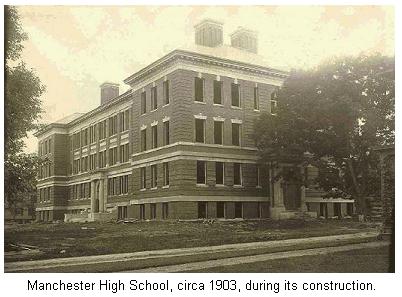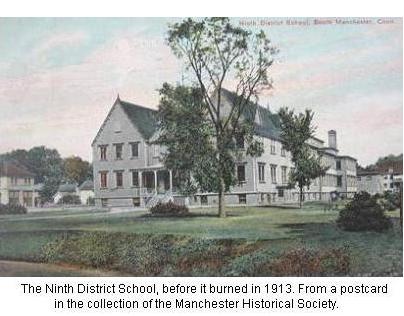
REPRINTS

Today, it�s hard to imagine building a school like the �old high school,� with all its glorious architectural details.
Today, we don�t design schools with columns, cornices, slate roofing, interior transoms, and wood paneling. The cost would
be out of reach and the �pay back� would surely be considered unjustifiable.
And yet, in 1904, when South Manchester High School first graced the south end of Main Street, the Cheney brothers,
who paid a small fortune to construct the building, did consider it worthwhile to erect such an edifice for the noble
purpose of educating the youth of Manchester.
At the time, the Cheney silk mills were booming, and the Cheney family shared the wealth, so to speak, in many
beneficent projects in town, including reservoirs, public utilities, and parks.
On Downtown walking tours that I lead, I have been pleased to show off the features of the old high school, now the
Bennet Apartments senior housing, at 1151 Main Street, and to enjoy comments from those who formerly attended school
there � either when it was still a high school or when it became a part of Barnard Junior High School.
Before South Manchester High School
In the 1923 �History of Manchester, Connecticut,� authors Mathias Spiess and Percy Bidwell tell the history of high
school studies:
�After the closing of the Center and the East Academies about the year 1870, there was no private institution in town
which provided instruction in high school subjects. In the Ninth District [the south end of Manchester], Dwight Bidwell,
who was principal of the Grammar School in the years 1871-1882, gave instruction to small groups of pupils in ... Latin and
Greek....
�For a number of years Manchester students attended the Hartford High School under an arrangement by which a fee of
$100 per year per pupil was paid by the town. In 1887 the establishment of a local high school was debated in town meetings
and a committee was appointed to report on the subject. The committee�s report was unfavorable and the subject was dropped.
In 1893 the Committee ... authorized the teaching of high school subjects. F. A. Verplanck was the first principal....
There were two courses of study, the classical or college preparatory, and the general course. The first class, graduated
in 1894, had six members.� Classes met in the large wooden Victorian-style Ninth District School, which was located on the
site of the present Bennet Academy on the east side of downtown Main Street.
Fred Ayer Verplanck (1860-1957)
 Mr. Verplanck, also known as �Zip,� served Manchester schools for 42 years. He had graduated from Windham (Connecticut)
High School, taught school during the winters of 1877 to 1883 in Franklin, Lebanon and Sprague, and graduated from Yale
College in 1888. After teaching at Bacon Academy, Colchester and Thomaston High Schools, he served as principal of the Model
School connected with the State Normal School at Willimantic. He came to Manchester in 1893 to serve as principal of the
Ninth District School.
Mr. Verplanck, also known as �Zip,� served Manchester schools for 42 years. He had graduated from Windham (Connecticut)
High School, taught school during the winters of 1877 to 1883 in Franklin, Lebanon and Sprague, and graduated from Yale
College in 1888. After teaching at Bacon Academy, Colchester and Thomaston High Schools, he served as principal of the Model
School connected with the State Normal School at Willimantic. He came to Manchester in 1893 to serve as principal of the
Ninth District School.
Mr Verplanck was known as a stern and serious educator. He knew all the students by name. �Combining clear vision with
executive ability of a high order, he has been largely responsible for the position of leadership in newer educational
activities which is now held by the Ninth District Schools,� according to authors Spiess and Bidwell.
In 1902, as plans progressed for the town�s own high school building, Mr. Verplanck, with the support of Cheney
brothers, conducted research on other modern schools and solicited proposals from several architectural firms.
Design
Architects Hartwell, Richardson & Driver of Boston were selected to design the building. They were the successor firm
of architect H.H. Richardson, who designed the seven-story �Richardson Building,� also known as Brown Thompson�s, built in
1876 on Main Street in Hartford for the Cheneys.
Although the high school building may seem elaborate to us today, it was certainly restrained compared to the
Richardson building in Hartford. Nevertheless, its colonial-revival style elements include a substantial front door with a
frontispiece and Doric columns, and the windows have keystones and various details above and below them. The corners of the
building feature a pattern of syncopated brick to add strength as well as character to the edges of the structure.
Building the High School
 At a spring 1902 meeting of the Ninth School District, the Cheneys� offer to erect a new school was accepted, and
construction left in their hands. In August 1902, the Cheney directors awarded the building contract to Beattie and Wilcox
of Fall River, Massachusetts, who had built the �new� velvet mills and other Cheney mills in Manchester.
At a spring 1902 meeting of the Ninth School District, the Cheneys� offer to erect a new school was accepted, and
construction left in their hands. In August 1902, the Cheney directors awarded the building contract to Beattie and Wilcox
of Fall River, Massachusetts, who had built the �new� velvet mills and other Cheney mills in Manchester.
According to an August 14, 1902 Hartford Courant article, �It has been said that the cost of the building would be
almost $100,000, but a member of the [Cheney] company speaking with the Courant ... said the cost would greatly exceed that
amount.... The building will be set well back from the road and will be partly shaded by the tall maple trees now standing
on the lot.... The building will give the appearance of being a four-story structure, the basement being well over ground.
The front length will be 173 feet and will have a depth of 86 feet. The ornamental features ... will be a large arched
doorway at the center and abutments. Between the north and south wings the space between the second and third floors is
divided off by panels. The windows will be numerous and ornamental ... at the north and south ends of the buildings will be
entrances similar to that which will be at the center, each having a landing and being arched in.... The hallways will run
through the center of the building and the stairs will be at the ends. At the ends of the halls will be drinking fountains.
In the basement at both ends will be rooms for storing bicycles, the girls having the north end of the building and the boys
the south. Large furnace and coal rooms will be there. The building will have the latest improved methods for ventilation
and the engines and fans to be used for circulating the air will be in the basement.� Classrooms had cloakrooms, to keep
hallways free of coat-hooks.
Dedication of the High School in December 1904
An all-day open house was held a week before the dedication of the building, and The Courant enthused that the building
was �very attractive from the outside, but the interior surpasses the exterior. The best time to see the school to
advantage will be in the evening when it will be lighted by 600 electric lights.�
Dedication ceremonies, held in the 5,200-square-foot assembly hall accommodating 900 people, included speeches and
music. The December 15, 1904 Courant, reporting about the festivities, noted that the school�s cost, originally reported as
$100,000, was more in the neighborhood of $160,000, which included furnishings in the art room, and a chemistry/physics lab
with gas jets, water and stone sinks, benches for microscopes, and ventilating arrangements for disposing of noxious gases.
The Courant called it �a monument to the generosity and benevolence� of the Cheneys.
High School into the Future
By 1906, the entering high school class numbered 83 Manchester residents, from the Eighth District (North End) as well
as South Manchester.
In March 1928, the Town purchased the high school, furnishings, and land from the Cheneys for $204,601.49. Howell
Cheney had proposed the sale to the town selectmen in 1927, saying that it was time that the town owned the school. The
land extended from Teachers Hall, south of the high school, all the way to Forest Street, excluding, on the north side of
the high school, the Army and Navy building and the house occupied by Mr. Verplanck and his family. The town also began
paying to heat and maintain the building.
In 1932, when Manchester�s school districts were consolidated, Principal Verplanck was promoted to Superintendent of
Schools. That same year saw the closing of Teachers Hall, the large wooden boarding house for teachers, with its curfews
and dress codes. Another operation that had closed was the Open Air School, south of Teachers Hall, which served students
with respiratory and other illnesses thought to be amenable to improvement through breathing fresh air even during the
winter.
As an aside, Mr. Verplanck was hailed as a hero for his role in preventing tragedy during the Ninth District School
fire of October 1913. Due to his insistence on installation of fire escapes, and on discipline and fire drills, the
students and staff in the wooden building made an orderly exit when flames were discovered. The school, a nearby library,
a fire station, and five dwellings burned to the ground, but not a single person was killed.


The burned Ninth District School was replaced in 1915 by Educational Square, a quadrangle of buildings that have
evolved into today�s Bennet Academy (although plans had called for demolition rather than renovation, and we are fortunate
that some concerned residents stuck their necks out and spoke up to save these buildings). The Cheneys paid for Educational
Square, including installation of a central heating plant, supplying heat to the high school via pipes under Main Street.
For more information on the fire in this web site, please click
Ninth District School Fire.
The old high school�s last graduates were the class of 1956, after which students went to the �new� high school on Middle Turnpike East, but the Main Street building continued to serve as part of Barnard (renamed Bennet) Junior High for decades. Converted to senior housing in 1984, its transoms, high ceilings, and huge assembly hall are gone, but it is still a handsome and solid building � a monument to the education of thousands of young people. With its classic Greek and Roman themes, the building surely inspired students to work toward lofty goals.
All content copyright 2025, Manchester Historical Society, founded 1965. All rights reserved.